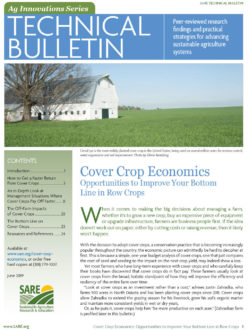| Budget Item
(All figures are per acre) |
Years of Cover Cropping | ||
| One | Three | Five | |
| Estimated input savings when using cover crops | |||
| Fertilizer1 | $0 | $14.10 | $21.90 |
| Weed control2 | $0-$15 | $10-$25 | $10-$25 |
| Erosion repair3 | $2-$4 | $2-$4 | $2-$4 |
| Subtotal | $2-$19 | $26.10-$43.10 | $33.90-$50.90 |
| a. Savings on inputs (the low end of the subtotal range from above) | $2 | $26.10 | $33.90 |
| b. Income from extra yield in normal weather year (survey data)4 | $3.64 | $12.32 | $21 |
| c. Cost of seed and seeding (survey data)5 | $37 | $37 | $37 |
| Net return in a normal weather year (a + b - c) | -$31.36 | $1.42 | $17.90 |
| Special situations where cover crops can pay off faster | |||
| I. When facing severe herbicide-resistant weeds6 | $27 | $27 | $27 |
| Adjusted net return | -$4.36 | $28.42 | $44.90 |
| II. Potential grazing income7 | $49.23 | $49.23 | $49.23 |
| Adjusted net return | $17.87 | $50.65 | $67.13 |
| III. Compaction addressed by cover crops8 | $15.30 | $15.30 | $15.30 |
| Adjusted net return | -$16.06 | $16.72 | $33.20 |
| IV. Assisting the conversion to no-till from conventional9 | $23.96 | $23.96 | $23.96 |
| Adjusted net return | -$7.40 | $25.38 | $41.86 |
| V. Income from extra yield in a drought year (survey data)10 | $58.70 | $75.73 | $92.55 |
| Adjusted net return | $27.34 | $77.15 | $110.45 |
| VI. Extra fertilizer savings from improved fertility11 | $15.20 | $15.20 | $15.20 |
| Adjusted net return | -$16.16 | $16.62 | $33.10 |
| VII. Federal or state incentive payments received12 | $50 | $50 | $50 |
| Adjusted net return | $18.64 | $51.42 | $67.90 |
|
1 Assumes no fertilizer savings in year one, then a savings of 15 pounds of nitrogen per acre in year three and 30 pounds per acre in year five, at $0.38 per pound. Also assumes a
phosphorus saving of 20 pounds per acre in year three and 25 pounds per acre in year five, at $0.42 per pound. 2 The first year assumes a reduction of one herbicide pass if sufficient cover crop biomass is achieved. Savings are higher in later years due to reducing by two passes or by using less-expensive herbicide products. 3 Based on the cost of machinery operations and labor to repair gullies and clean ditches (assumes average cost, but fields will vary). 4 Assumes a corn price of $3.50 per bushel and a 200-bushel yield times the percent yield increases shown in Table 2. 5 Costs for seed, seeding and termination can vary from a low of about $10 to over $50 per acre; most farms estimated to be $25–$40 per acre. 6 In a field with a severe herbicide-resistant weed infestation, this figure assumes that a thick-biomass cover crop will reduce herbicide and labor costs and will reduce dockage for weed seed at harvest. 7 Assumes that grazing a cover crop (cereal rye in this example) results in a reduction of 1,093 pounds of hay fed per acre of cover crops. This is based on 1,500 pounds per acre of dry matter generated by rye, then reduced effective use of the rye by 50% due to hoof action and selective grazing. Assumes average feedlot waste of 22% for hay fed (88% dry matter). The hay is valued at $80 per ton. Additional savings of approximately $5.50 per acre generated due to lower labor, fuel and machinery depreciation from reduced hay fed. Assumes grazer already has water access for their grazing area and an electric fencing system. 8 This is based on a University of Minnesota machinery cost estimate for subsoiling at $15.30 per acre (2017 data used for machinery costs). 9 No-till savings versus conventional: No fall chisel plow ($11.22 per acre) and savings on two field cultivator passes in the spring (2 x $6.37 per acre). 10 Assumes a corn price in drought of $6.89 per bushel and reduced base yield of 142 bushels per acre x percent yield increase for drought. Numbers are based on actual national average corn yield for 2012 and national average corn price in the 2012–13 marketing year (USDA-NASS). 11 Assumes using legumes as a cover crop and that overall improved soil health allow nitrogen to be cut by an extra 40 pounds per acre over basic fertilizer savings. 12 The basic NRCS EQIP rate in the majority of Corn Belt states starts at $50 per acre or higher; some states have lower rates. |
|||
Cover Crop Economics
Table 4. Cover Crop Budget for Corn in 1, 3 and 5 Years Under Various Management Scenarios
SARE Outreach
| 2019 | 24 pages
